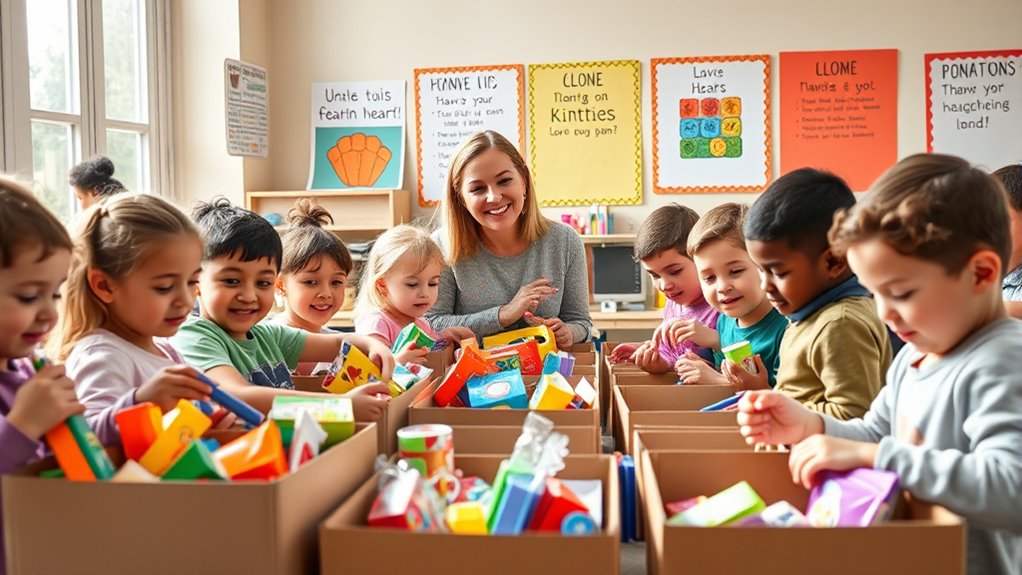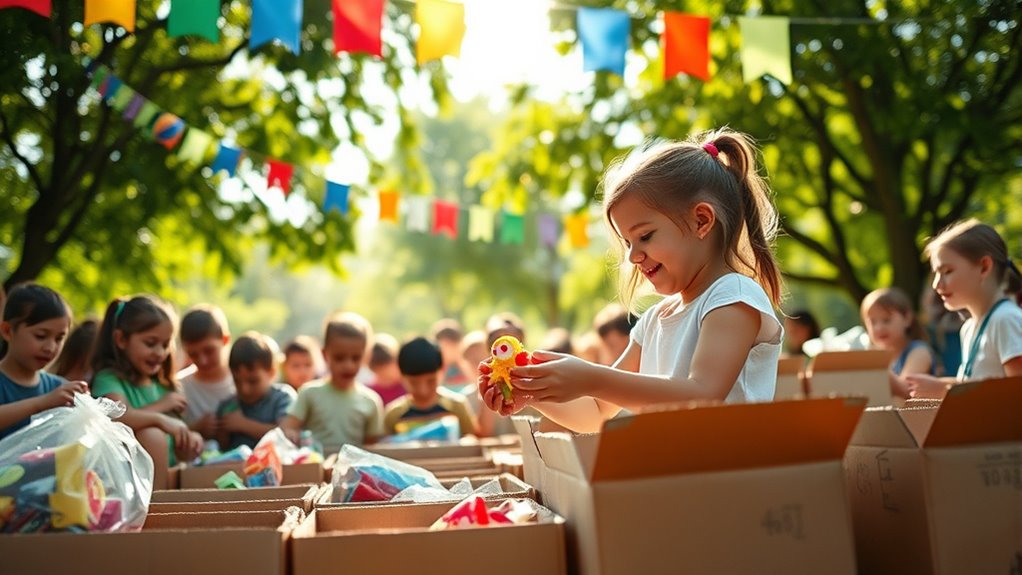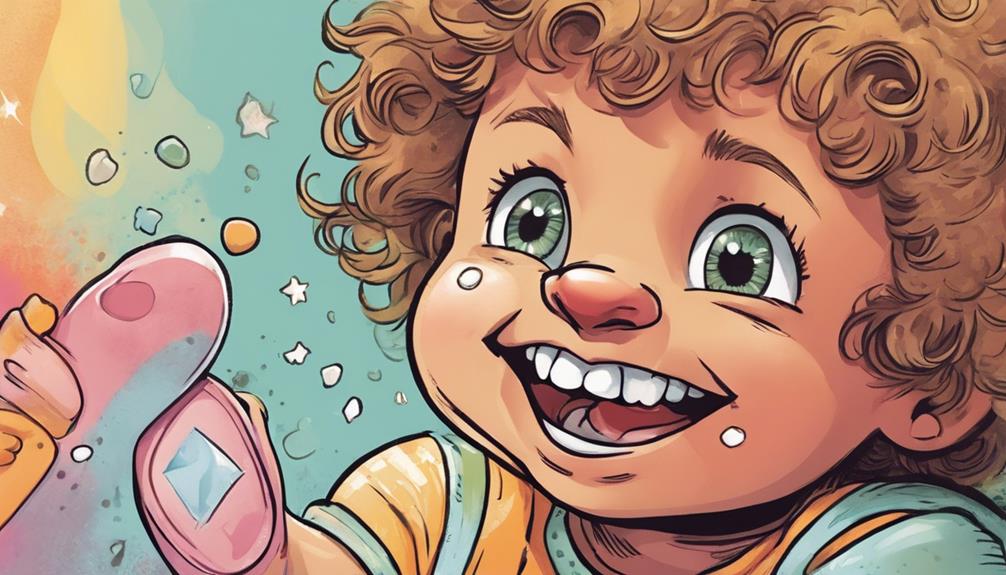Teaching kids empathy through toy and food drives helps them see the impact of their kindness firsthand. As they organize and give, they learn patience, perseverance, and the importance of teamwork. Celebrating acts of generosity reinforces positive behavior, while discussions about social issues deepen their understanding of others’ struggles. These experiences foster compassion that lasts beyond the activity, guiding children to become more caring individuals. Keep exploring to discover more ways to nurture empathy in young hearts.
Key Takeaways
- Participating in drives allows children to see the real impact of kindness, fostering empathy through tangible acts of helping others.
- Celebrating recipients’ joy reinforces the importance of generosity and motivates kids to continue compassionate behaviors.
- Organizing donations teaches patience and perseverance, helping children understand effort and resilience in service.
- Collaborative planning and teamwork develop communication skills and empathy through shared goals and mutual respect.
- Discussing social issues during drives deepens kids’ awareness of societal challenges, nurturing socially conscious and empathetic individuals.

Teaching kids empathy is essential for helping them build meaningful relationships and develop emotional intelligence. When you involve children in toy and food drives, you give them practical opportunities to practice empathy in real-world situations. These activities allow kids to see firsthand how their actions can make a difference in someone else’s life. By encouraging them to participate actively, you help foster a sense of compassion and understanding that will stay with them long after the drives are over.
Celebrating kindness through these drives is a powerful way to reinforce positive behavior. When children see the joy their donations bring to others, they begin to understand the importance of generosity. You can highlight stories of recipients who receive toys or food, making the act of giving more tangible. As kids witness the impact they have, they learn that small acts of kindness can have a profound effect. This recognition not only boosts their confidence but also encourages them to continue practicing kindness in everyday situations.
Developing patience is another indispensable skill that these drives help nurture. Kids often learn that collecting and organizing donations takes time, effort, and cooperation. You can teach them that patience is necessary when waiting for their turn to contribute or when sorting and packing items. This process helps build resilience and understanding that good things sometimes require time and perseverance. As they navigate these tasks, they develop a sense of responsibility and learn to appreciate the value of steady effort.
Involving children in planning and executing the drive also teaches them about teamwork and communication. They learn to collaborate with peers and adults, sharing ideas and listening to others’ perspectives. This collaborative effort reinforces respect and empathy, as they see that working together often yields better results. Celebrating their collective success can motivate kids to continue engaging in acts of kindness and develop a lifelong commitment to helping others.
Furthermore, these drives provide a platform to discuss broader social issues with children, such as poverty and hunger. You can use this time to educate them about the challenges others face and inspire a deeper sense of empathy. As they understand these struggles, kids become more aware of the importance of community and the impact of their actions. It’s a chance to instill values that extend beyond the immediate act of giving, shaping them into compassionate, socially aware individuals. Additionally, understanding the importance of social bonds can help children see how their actions connect with broader community efforts.
Frequently Asked Questions
How Can Parents Motivate Reluctant Children to Participate?
To motivate reluctant children, use engaging strategies like explaining the impact of their help and making participation fun. Offer small rewards or praise to boost their confidence. Share stories that connect emotionally, helping them see the importance of giving. Use engagement tips such as involving them in decision-making or setting achievable goals. Your enthusiasm and patience will encourage them to join willingly, making the experience meaningful and rewarding for both of you.
What Age Is Best for Starting Empathy-Focused Drives?
Think of empathy as a seed planted early; the best age to start drives depends on your child’s developmental stage. Around ages 4-6, children begin grasping others’ feelings, making it ideal for age considerations. You can nurture this growth through simple toy and food drives, helping your child develop compassion and social awareness. Starting early, aligned with their maturity, builds a strong foundation for lifelong kindness.
How Do Cultural Differences Impact Empathy Teaching Strategies?
Cultural differences considerably impact how you teach empathy, as cultural perspectives shape empathy expression. You should tailor your strategies to respect diverse values and customs, encouraging children to understand and appreciate different ways of showing care. By acknowledging these differences, you help kids develop a more inclusive and genuine empathy, fostering better cross-cultural understanding and compassion. This approach ensures your efforts resonate deeply across various cultural backgrounds.
Can Virtual Toy and Food Drives Be Effective for Teaching Empathy?
Think of virtual toy and food drives as digital gardens where your kids plant seeds of kindness. While they might not share a physical space, these efforts foster digital engagement and community involvement, helping children understand and feel empathy. Though less tangible, these online initiatives can be just as impactful, teaching children to care for others beyond their immediate surroundings and nurturing a sense of global compassion.
What Are Common Challenges Faced When Organizing These Drives?
When organizing toy and food drives, you often face challenges in community engagement and donation logistics. You might struggle to motivate participation or reach your target audience. Managing donation logistics can be complex, as you need to coordinate collection points, transportation, and storage. These hurdles can hinder your efforts to teach kids empathy effectively, but with clear planning and outreach, you can overcome them and make a meaningful impact.
Conclusion
By involving kids in toy and food drives, you help them see beyond themselves and develop genuine empathy. These activities teach compassion, kindness, and the importance of giving back. When you show children how their actions can make a difference, you’re planting seeds of empathy that grow over time. So, aren’t you excited to watch your kids become caring, understanding individuals who make the world a better place? Together, you can inspire a lifelong habit of kindness.









